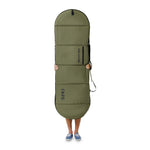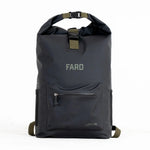
Surfboards are built for freedom, but they also require the right protection—especially when you’re on the move. Whether you're taking your board to a local break or planning a flight across continents, choosing between a day bag and a travel surfboard bag is critical.
In this guide, we’ll break down the key differences between the two bag types, explore the ideal use cases for each, and help you choose the right option using FARO’s surfboard bag collection as a reference.
Why the Right Surfboard Bag Matters
A good board bag protects your investment from UV rays, dings, and transport damage. A great board bag also makes your journey easier—whether you're walking to your local break or packing gear for a surf trip overseas.
The choice between a day bag and a travel surfboard bag depends on:
- How far you're travelling
- The transportation method (car, plane, scooter, etc.)
- The value and fragility of your board
- Your packing habits and travel conditions
With the right bag, your board arrives safe—and you arrive stress-free.
Day Bag vs Travel Surfboard Bag: Key Differences
Let’s start with a direct comparison of these two surfboard bag types:
|
Feature |
Day Bag |
Travel Bag |
|
Primary Use |
Daily beach trips |
Long-distance travel (flights, road trips) |
|
Padding Thickness |
5mm–10mm foam |
10mm–20mm multi-layer foam |
|
Weight |
Lightweight |
Heavier and more reinforced |
|
Size Fit |
One board |
Often fits multiple boards |
|
Storage Pockets |
Minimal or none |
Multiple compartments |
|
Protection Level |
Moderate (bumps, sun, minor scrapes) |
High (baggage handling, stacking, pressure) |
|
Cost |
Lower cost |
Premium pricing due to added materials |
A day bag is perfect for the regular commuter surfer. A travel surfboard bag is built to withstand serious handling—think baggage handlers, layovers, and long rides in roof racks.
Explore both types in FARO’s surfboard bag collection to get a feel for their design and durability.
Foam Padding Thickness: A Critical Factor
Padding is one of the most important differences between a day bag and a travel surfboard bag.
Day Bags typically include 5mm to 10mm closed-cell foam, just enough to cushion your board in your car or on foot.
Travel Bags may feature 10mm to 20mm multi-layer padding, with added reinforcement on the nose, tail, and rails.
This extra thickness matters when your board is being dropped, stacked, or jammed in overhead compartments. It absorbs impact and shields against pressure dings. To understand how this type of foam works, refer to this Wikipedia article on polyethylene foam, which explains its shock-absorbing and water-resistant properties.
Learn more about the materials and padding specs in FARO's blog articles.
Zipper vs Roll Top Closures: Which Is Better?
Board bags come in two main closure styles: zippers and roll tops. Each offers unique advantages depending on your travel style.
Zipper Closures
- Most common in both day and travel bags
- Quick access
- Can sometimes corrode in saltwater environments (unless rust-resistant)
Roll Top Closures
- Common in eco-friendly and minimalist bags like those from FARO
- Offer superior waterproofing
- Eliminate zipper failure—ideal for humid or sandy climates
FARO’s canvas bags use industrial roll-top closures with ykk buckles for a secure, zipper-free system. This is part of what makes them both functional and long-lasting.
Use Case Scenarios: Which Bag Suits Your Surf Trip?
If you’re still torn between day bag vs travel surfboard bag, here’s how to choose based on your situation:
Use a Day Bag if:
- You surf daily or weekly at nearby beaches
- You transport your board in your own car
- You want lightweight protection without overpacking
- You're storing your board indoors
Use a Travel Bag if:
- You're flying with your board
- You plan to stack multiple boards or gear
- You're storing your board for extended periods
- You travel by train, bus, or public transport
Airline Surf Gear: What to Pack and How
Travelling with your surfboard on an airline? Here’s what matters most:
- Choose a travel surfboard bag with 10mm+ padding
- Remove fins or choose bags with fin slot openings
- Add clothes or wetsuits inside the bag for extra cushioning
- Use rail protectors or board socks inside for added abrasion resistance
Some airlines have strict rules on size and weight. Always check baggage policies before you book. For reference,FARO’s guide to travelling with surfboards offers helpful tips on how to pack efficiently, reduce fees, and avoid common mishaps. FARO’s bags are designed with airline dimensions in mind, making them a go-to choice for surf travellers.
FARO Product Examples: Day and Travel Bag Comparison
Here’s how FARO’s bags stack up based on your travel needs:
FARO Day Bag Equivalent:
- Material: recycled canvas with padded nose
- Closure: Roll-top, rust-proof hardware
- Use: Short trips, walkable breaks
-
Key Feature: Breathable fabric reduces heat buildup, lightweight.
Check out their eco-conscious board bags built for durability and daily use.
FARO Travel Bag Equivalent:
- Material: Padded canvas or reinforced ripstop
- Padding: 10mm+ with impact protection zones
- Closure: Heavy-duty zippers or roll-top variants
- Use: Airline travel, long road trips
- Key Feature: Extra space for gear and double layering
For help choosing the right size, visit the FARO contact page and get a custom recommendation based on your board specs.
Final Thoughts
Understanding the difference between a day bag and a travel surfboard bag helps you make an informed decision, based on how and where you surf.
Day bags are built for daily use—lightweight and simple. Travel surfboard bags are designed for adventures—durable and feature-rich to withstand transit stress.
FARO offers thoughtful solutions that balance aesthetics, functionality, and sustainability—whether you’re walking to the beach or flying halfway across the world.
Explore your options with FARO's surfboard bag collection, or follow FARO on Instagram to see their bags in action.





